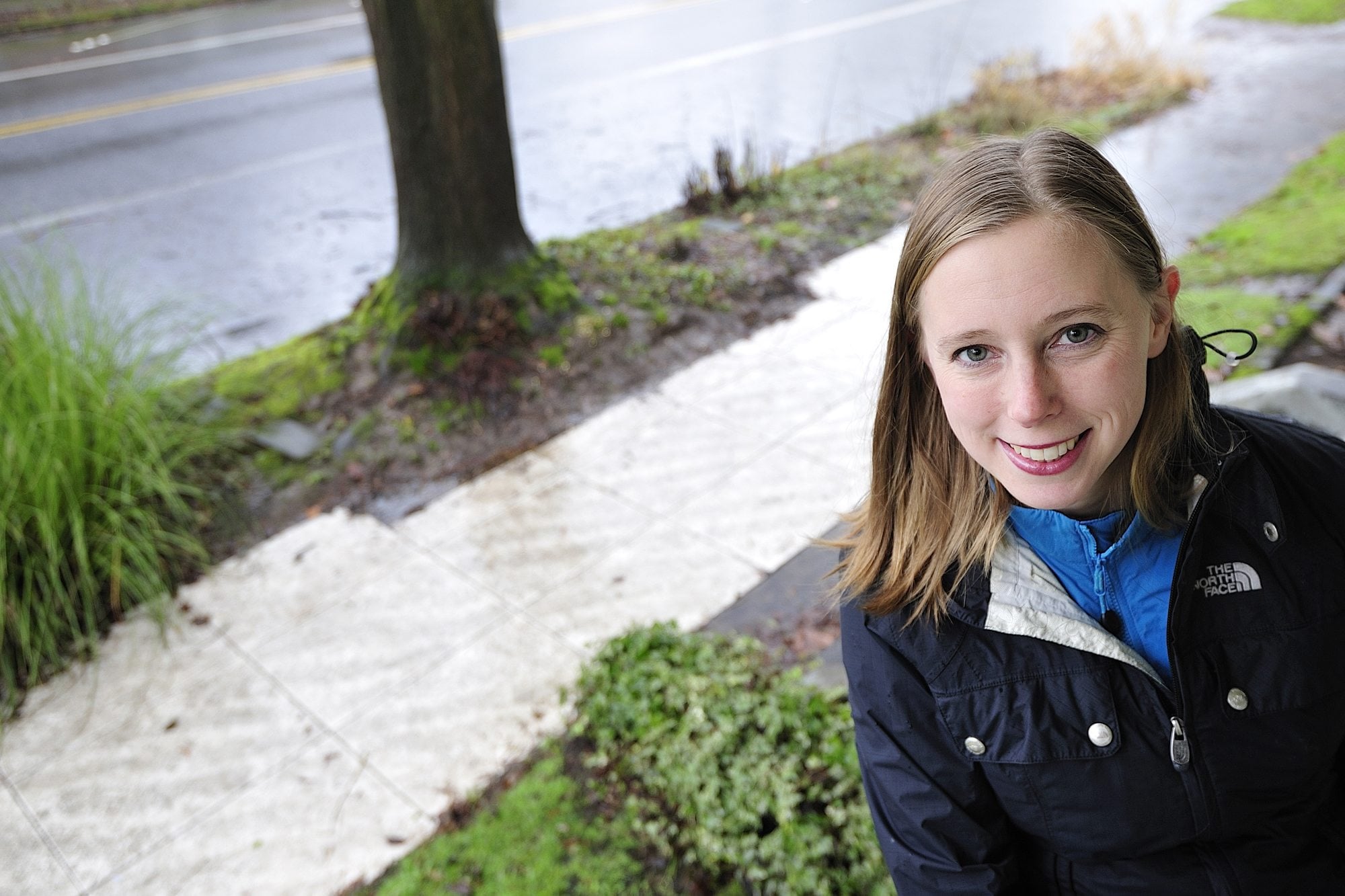As one of Vancouver’s oldest neighborhoods, Hough has its share of large, old trees. The trees shade the neighborhood’s collection of bungalows, foursquares and Victorians in the summer, calm drivers and increase property values. But their expansive root systems also cause sidewalk cracks and upheaval, presenting tripping hazards and requiring costly repairs.
“Last year, sidewalks were a big topic in Hough,” said Melissa Tiefenthaler, co-chair of the Hough Neighborhood Association. “I started thinking maybe it’s not the trees’ fault; maybe it’s the sidewalks’ fault.”
Tiefenthaler, 32, drew from the knowledge she’d learned from studying urban forestry as part of earning a master’s degree in urban and regional planning from Portland State University to come up with a resolution to Hough’s conflict with nature.
Rubber sidewalks, used in about 60 cities nationwide, continually bounced back to her mind. And Vancouver’s first rubber sidewalk was conceived.
Rubber sidewalks have been used in playgrounds and equestrian tracks for some time. Nowadays, they’re gaining popularity worldwide for use in sidewalks for a variety of reasons. San Francisco opted for them to reduce maintenance costs. Pub owners in Sydney, Australia have installed them to soften the fall for drunken customers who get into brawls. The nearest rubber sidewalks are in Olympia and Wilsonville, Ore.
The sidewalks are flexible enough to accommodate growing tree roots without cracking but also offer other benefits. Made of recycled materials, the sidewalks are environmentally conscientious. They allow nearly 98 inches of rainwater to seep into the ground beneath the sidewalk. The water absorption encourages tree roots to grow deeper under the ground away from sidewalks, reducing the risk of sidewalk cracking and upheaval. That results in fewer sidewalk repairs and maintenance costs.
Rubber sidewalks are often installed as pavers, which can be easily removed to prune tree roots and switched out without replacing the entire sidewalk.
Tiefenthaler applied for and received a $3,078 grant from the Vancouver Office of Neighborhood’s Safe Neighborhoods Street Fund to help pay for a demonstration project to install a rubber sidewalk along one of Hough’s streets.
“I was able to get that grant because trees have a calming effect on drivers,” Tiefenthaler said. “The trees cause drivers to perceive the street as much narrower than it actually is, so they slow down.”
Vancouver Watersheds Alliance contributed another $1,500 toward the project because trees help decrease stormwater runoff and filter air pollutants.
Tiefenthaler wrote a blurb in the neighborhood newsletter asking homeowners to volunteer their broken sidewalks for the demonstration project.
Hough resident Shelly Strom and her husband, Jeff Jackman, were among the respondents. The roots of a linden tree had heaved up the sidewalk in front of their home at 405 W. McLoughlin Blvd., causing a nearly 4-inch concrete tripping hazard and an accumulation of water and dirt at the bottom of their front porch stairs, Strom said.
“We have been in our home since 1997, and the sidewalk has been on our to-do list,” Strom said. “There were always things we did on the house instead of that. Melissa said she had gotten grant money that was about to expire. We were interested in any kind of financial help.”
Their sidewalk was chosen for the demonstration project because the couple agreed to contribute $356 toward the project and because their sidewalk segment is a heavily traveled area across from Hough Elementary School.
The project’s cost quickly ballooned because it was the first of its kind in the city. That meant Tiefenthaler had to apply for a road modification permit at a cost of $2,087.
“A road modification is the standard modification if you want to deviate from the city’s standard materials,” explained Matt Ransom, city of Vancouver planning manager. “We need to go through that process to make sure the material is safe.”
Tiefenthaler was able to reduce the permit charge to $1,077.
Tiefenthaler chose Terrewalks rubber pavers from Rubbersidewalks Inc. for the sidewalk material.
“I liked the style of the sidewalk because of the interlocked pavers that can be removed so trees can be pruned and lets water in between to encourage tree roots to grow deeper,” Tiefenthaler said.
Woody’s Custom Landscaping out of Battle Ground removed the old sidewalk, pruned protruding roots, excavated and filled the land beneath and installed the rubber pavers in August. The total cost for the project was about $4,800, a combination of contractor services, permits, and materials.
The new sidewalk has eliminated both the tripping hazard and the mud puddles outside Strom and Jackman’s doorstep, Strom said.
“It’s wonderful the sidewalk is safe again,” Strom said. “There is no mud puddle.”
However, she said mold is more noticeable on the pavers because they’re a lighter color than concrete.
Tiefenthaler said the sidewalk has sparked interest in the neighborhood in installing other rubber sidewalks. Ransom said the city could eventually make rubber a standard sidewalk material once they’re able to observe how the sidewalk holds up over time.
“That’s my first hope that other people will consider alternatives to regular concrete,” she said.



